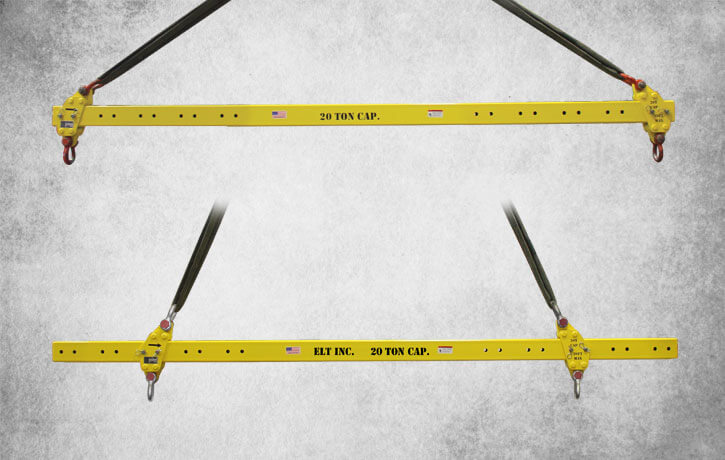How to Calculate Sling Angles for Safe Lifting Operations

Lifting operations in construction, shipping, and manufacturing often involve slings to secure and lift loads. To ensure safe lifting, understanding how to calculate sling angles is crucial. The angle at which a sling is used affects the sling’s tension and the lift’s safety. Below, we’ll explain how sling angles impact lifting operations, how to calculate them and provide practical safety tips.
Understanding Sling Angles
The sling angle is the angle formed between the sling and the horizontal surface of the load. When a sling is used at a steeper angle (closer to vertical), it exerts less tension on the sling itself. Conversely, a lower angle (closer to horizontal) increases the tension on the sling, which can compromise safety. Calculating the sling angle is vital to avoid exceeding the sling’s load limit and ensuring a stable and secure lift.
The Impact of Sling Angles on Tension
As the sling angle decreases, the tension in the sling increases. This effect results from vector forces: at lower angles, the horizontal force component exerted by the sling increases. If the sling angle becomes too shallow (below 30 degrees), the tension increases significantly, potentially leading to sling failure or slippage of the load. Understanding the relationship between sling angles and tension can help prevent accidents and equipment damage.
The Formula for Calculating Sling Angle Tension
The tension in a sling can be calculated using the following formula:
T= W / (2 x cos (θ) )
Where:
- T is the tension in the sling.
- W is the weight of the load.
- θ is the sling angle relative to the horizontal.
For example, if a load weighs 1,000 pounds and the sling angle is 45 degrees, the calculation would be:
T = 1000 / 2 x cos (45∘) ≈ 707 pounds
This formula shows how the angle affects tension: as the cosine of the angle decreases (with lower angles), the tension increases.
Determining Sling Angles
To calculate the sling angle, you need to measure two components:
- Height (H): The vertical distance from the load to the attachment point of the sling.
- Length (L): The horizontal distance between the attachment points on the load and the lifting point.
The sling angle can be found using the formula:
Sling Angle (θ) = arctan (H/L)
For instance, if the height is 3 feet and the horizontal distance is 4 feet, the sling angle would be:
Sling Angle (θ) = arctan (3/4) ≈ 36.87∘
Knowing this angle allows you to accurately calculate the tension on the sling and determine whether it falls within the safe working load limit.
Sling Angle Chart: A Quick Reference
Many rigging professionals use a sling angle chart to determine the tension factors based on common angles quickly. These charts provide a “tension multiplier” for specific angles, which gives the resulting sling tension when multiplied by the load weight. Here’s an example of how tension factors work for different sling angles:
- 90 degrees: Tension Factor = 1.0
- 60 degrees: Tension Factor = 1.15
- 45 degrees: Tension Factor = 1.41
- 30 degrees: Tension Factor = 2.0
At 90 degrees, the sling carries the load weight directly. However, due to the added horizontal force component, the tension multiplier increases at lower angles.
Safe Lifting Practices with Sling Angles
- Avoid Low Sling Angles: Always try to maintain sling angles above 45 degrees to minimize tension. Angles below 30 degrees are particularly hazardous due to the significant increase in tension.
- Use Longer Slings When Necessary: If the lifting setup results in a shallow sling angle, use a longer sling to increase the angle and reduce tension.
- Check Sling Load Capacity: Verify that the sling’s rated capacity is sufficient for the calculated tension, factoring in the sling angle.
- Inspect Slings Regularly: Sling wear and damage can weaken lifting capacity. Inspect slings before each use, paying special attention to the wear points and connection areas.
- Employ Sling Angle Calculators: Online calculators or mobile apps can simplify the calculation process, helping to ensure quick and accurate assessments.
Common Mistakes in Sling Angle Calculations
- Neglecting to Measure Properly: Incorrect height and length measurements can lead to inaccurate sling angle calculations, increasing the risk of improper load distribution.
- Misinterpreting Tension Factors: Not understanding how the tension factors relate to sling capacity can result in choosing a sling that’s not rated for the actual load tension.
- Ignoring Environmental Factors: Environmental conditions, such as wind or uneven terrain, can impact the stability of the load and the effectiveness of the sling setup.
Practical Example: Calculating Sling Tension
Imagine lifting a 2,000-pound load using a sling with an angle of 30 degrees. The tension in the sling can be calculated as follows:
- Calculate the cosine of 30 degrees: cos(30∘) ≈ 0.866
- Plug into the formula: T= 2,000 / (2×0.866) ≈ 1,154 pounds
The tension in each sling leg would be approximately 1,154 pounds, which needs to be within the sling’s rated capacity for safe lifting.
Using Multiple Slings and Load Distribution
When using multiple slings, the load is typically distributed among them. However, the same principles apply: the sling angle affects the tension in each sling. When calculating multiple slings, ensure each sling is rated for the calculated tension and the load evenly distributed.
_______________________
Calculating sling angles is critical to planning safe lifting operations. The angle directly affects the tension on the sling, making it essential to understand how to calculate and adjust for different angles. By following the formulas and safety practices outlined above, you can ensure safer lifting operations and reduce the risk of accidents. Regular training, proper equipment selection, and accurate calculations will help maintain a safe work environment when performing lifting operations.




